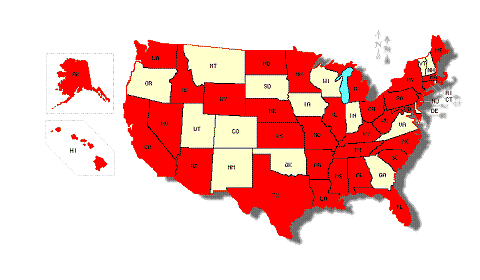CMS Finds Fault with Exclusion Information Sharing Between States
I. Take It from CMS: If You’re Excluded in One State, You’re Excluded in All States
Section 6401(b)(2) of the Affordable Care Act (ACA) required the Centers for Medicare and Medicaid Services (CMS) to create a national database where State agencies could share and access information about individuals and entities that were terminated from the Medicare, Medicaid, or CHIP programs.[1] This platform would help states comply with ACA section 6501,[2] which mandates that a provider must be terminated in all state Medicaid programs if he or she were terminated “for cause”[3] in one state. CMS created the Medicaid and Children’s Health Insurance Program State Information Sharing System (MCSIS) to make this exclusion information available to all State Medicaid agencies.[4]
Under section 6401(b)(2), states were asked to submit the terminated provider’s name, National Provider Identifier (NPI), and other identifying information to MCSIS. This information was incorporated into MCSIS so that other states could identify providers that needed to be terminated. Even though CMS has the authority[5] to require states to submit this information, it has only asked states to comply. CMS’ failure to make reporting mandatory resulted in a very deficient database.
II. CMS’ Comprehensive List…Not So Comprehensive
Only thirty-three states[6] submitted information to CMS and many of the records were incomplete. For example, CMS asked states to only submit providers that were terminated “for cause,” but over 2,000 records lacked a “for cause” termination.[7] In addition, 59 percent of the records also did not include provider NPIs,[8] which the ACA specified as a mandatory database component.[9] Many other data fields, like provider type[10] and address, were blank.
Seventeen states[11] and the District of Columbia failed to submit any data in the two years between MCSIS’s creation and the Office of the Inspector General’s (OIG) review.[12] Four states[13] submitted 72 percent, or 3,413 of 4,713 total Medicaid records.[14] The other states that reported information reported very small numbers. For example, Massachusetts only submitted two excluded providers between 2011 and 2013.[15] Even though, it excluded fifteen providers in 2012.[16]
OIG concluded that CMS needed to improve its exclusion information-sharing process.[17] Specifically, CMS should mandate that state agencies report all “for cause” terminations.[18] OIG also stated that CMS should also remove all providers that were not terminated “for cause,” or if it would like to expand its database, then it must issue new guidance instructing the states as to which providers must be terminated under section 6501.[19]
III. CMS Creates New List: OnePI Portal
CMS agreed with OIG, and disclosed that it is in the process of creating a private database, the OnePI portal.[20] OnePI is accessible to only CMS, State Medicaid agencies, and CHIP. It provides a private platform for states to share information about terminated providers.
Under this new system, CMS will require states to submit a copy of the termination letter sent to the provider. Then, CMS will review these letters to ensure that the provider should be included in the OnePI database.[21]
CMS has not provided a proposed completion date for OnePI.[22] Furthermore, there is no information available in regard to whether this data will be incorporated into the LEIE, if it will be available to providers, or if states will be required to integrate excluded providers from other states into their Medicaid termination lists.
IV. Conclusion
This inaccurate reporting of data illustrates why it is critical to check all state Medicaid lists in addition to OIG-LEIE and GSA-SAM. You will be held responsible if you employ or contract with an excluded individual. A provider that is excluded in one state is excluded in all states.
Ashley Hudson, Associate Attorney at Liles Parker, LLP and former Chief Operating Officer for Exclusion Screening, LLC, is the author of this article. Contact the exclusion experts at Exclusion Screening, LLCSM today for a free consultation by calling 1-800-294-0952 or online.
[1] Dep’t of Health and Human Servs. Office of the Inspector Gen., CMS’s Process for Sharing Information about Terminated Providers Needs Improvement, 1–2 (Mar. 2014).
[2] 42 C.F.R. § 455.416(c).
[3] States are only required to terminate providers from their Medicaid programs if they were terminated “for cause” under another state program. “For cause” means a provider was terminated due to fraud, integrity or quality. Dep’t of Health and Human Servs. Office of the Inspector Gen., supra note 1, at 2.
[4] Dep’t of Health and Human Servs. Office of the Inspector Gen., supra note 1, at 1.
[5] Dep’t of Health and Human Servs. Office of the Inspector Gen., supra note 1, at 13.
[6] Dep’t of Health and Human Servs. Office of the Inspector Gen., supra note 1, at 7.
[7] Dep’t of Health and Human Servs. Office of the Inspector Gen., supra note 1, at 7.
[8] Not all providers are assigned NPIs. Dep’t of Health and Human Servs. Office of the Inspector Gen., supra note 1, at 4, 9.
[9] Dep’t of Health and Human Servs. Office of the Inspector Gen., supra note 1, at 2.
[10] Thirty-three percent of MCSIS records did not contain information about the provider type. Furthermore, some states identified 95 percent of providers as “other” when 25 different specific provider types were provided in a drop-down menu. See Dep’t of Health and Human Servs. Office of the Inspector Gen., supra note 1, at 11.
[11] The seventeen states were: Colorado, Hawaii, Kentucky, Minnesota, Montana, New Hampshire, New Mexico, North Carolina, North Dakota, Oklahoma, Oregon, South Carolina, South Dakota, Texas, Utah, West Virginia, and Wyoming. See Dep’t of Health and Human Servs. Office of the Inspector Gen., supra note 1, at 16.
[12] Dep’t of Health and Human Servs. Office of the Inspector Gen., supra note 1, at 7.
[13] California, New York, Pennsylvania, and Illinois. See Dep’t of Health and Human Servs. Office of the Inspector Gen., supra note 1, at 7.
[14] Dep’t of Health and Human Servs. Office of the Inspector Gen., supra note 1, at 7.
[15] Dep’t of Health and Human Servs. Office of the Inspector Gen., supra note 1, at 16.
[16] Massachusetts Health and Human Services, Suspended/Excluded MassHealth Providers as of 5/31/2014, 2, http://www.mass.gov/eohhs/docs/masshealth/provlibrary/suspended-excluded-masshealth-providers.pdf (last accessed June 6, 2014).
[17] Dep’t of Health and Human Servs. Office of the Inspector Gen., supra note 1, at 13.
[18] Dep’t of Health and Human Servs. Office of the Inspector Gen., supra note 1, at 13.
[19] Dep’t of Health and Human Servs. Office of the Inspector Gen., supra note 1, at 14.
[20] Dep’t of Health and Human Servs. Office of the Inspector Gen., supra note 1, at 22.
[21] Dep’t of Health and Human Servs. Office of the Inspector Gen., supra note 1, at 22.
[22] Dep’t of Health and Human Servs. Office of the Inspector Gen., supra note 1, at 22–23.


